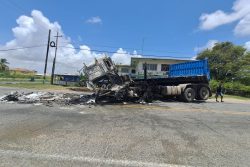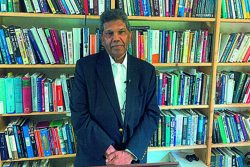Dear Editor,
The politicization and racialization of the Land Commission of Inquiry (COI) have served to undermine and discredit the real importance of solving our land issues. Of course in 2007, even when the PPP Government agreed it was needed, nothing was done.
For those concerned about why the COI looks at Amerindian and African land issues, the very ethnic trap Dr. Hinds spoke about is very evident here again. The PPP has taught its followers that anything this government does for Africans is favouritism and anything it does not do to support Indians, regardless of the merit, is anti-Indian. Guysuco is a great example.
Perhaps, this is why the government acted as it did and dealt with land for all groups under this COI.
Nevertheless the ethnic fear of Amerindians losing their land is a false claim.
The Amerindian Act of 2006 provides Amerindians with 13.8% of Guyana and no land Commission or political circus or media hysteria can change that fact. It is the law of the land passed by unanimously in Parliament.
There are however many important reasons why the Land COI is very important to all Guyanese
The first critical issue is centred on our national sovereignty. In as much as our Amerindian communities may focus primarily on land titling issues, many of the areas in their 13.8% of Guyana lie contiguously with the sovereign borders of Brazil. Moreso, many of these lands lie in the Venezuelan claim on Essequibo. Our Wai Wais have 1.5 million acres of land at the border with Brazil, and this complete area is a part of the Venezuelan claim.
Sovereignty belongs to the State and not to individual groups. If there was an invasion onto or into Wai Wai lands, it is the Government of Guyana that would have to defend Guyana’s sovereignty. If any agreement is signed with foreign entities, it will have to be under Guyanese Law. It would be the State of Guyana and the Guyana Defence Force that will have to intervene if an invasion occurs or a problem arises.
This is again evident with Venezuelan claims on our oil find. It is the State that would have to address these subsurface rights issues on our behalf under Law of the Sea international protocols. This is also the problem with the ownership of subsurface rights in any community in any part of Guyana. If land is confiscated or occupied by another State, it is still the sovereign state of Guyana that has to address the issue.
The second important issue that supports the need for a Land COI is that of a national development planning. National Land Use planning is a necessary precursor to national integrated planning. This has to be done in a holistic manner. The Terms of Reference (TOR) of the Land COI states that its goal is “to examine and make recommendations to resolve all issues and uncertainties surrounding the claims of Amerindian land titling, the individual and joint ownership of lands acquired by freed Africans and any matters relating to land titling in Guyana”.
Guyana has signed on to the United Nations 2030 Agenda for Sustainable Development. Goal 15 of the 2030 Agenda mandates that Guyana “…protect, restore and promote sustainable use of terrestrial ecosystems, sustainably manage forests, combat desertification, and halt and reverse land degradation and halt biodiversity loss”. It is the Guyana government, through holistic land management strategies that is responsible for the strategies, plans and monies to ensure compliance with Goal 15. The Land COI has to be conscious of these commitments as it provides recommendations to the Parliament of Guyana.
Critically, the Guyana Government funds national development out of the Treasury as seen in the last budget. It also has to fund the implementation of domestic and global commitments under the Low Carbon Development Strategy (LCDS) and the Green State Development Strategy (GSDS). Guyana has made commitments to Norway to reduce deforestation. Guyana has also made commitments at the United Nations through our Nationally Determined Indicators. Recently, Guyana committed to another 2 million hectares of land for conservation after having done so previously by committing 371,000 hectares for the establishment of the Iwokrama Centre for Rainforest Conservation and Development in the centre of the Guiana Shield. The land COI again will be armed with knowledge of these commitments as they listen to various groups presenting their positions.
In reality, the members of the land COI have a very important task ahead of them. It is not just about land titles and the issues associated with these from various stakeholders, it is also about proving a well-articulated understanding of the various interest, commitments and development needs in Guyana.
Thirdly, the land COI has to remember that Guyana needs a new Capital. Regardless of the permanent denial Guyanese live in, Georgetown is not sustainable as Guyana’s long term capital given the coast is six feet below sea level, the irreparable state of our sea walls and predicted climate change impacts.
Fourthly, Guyana has committed to becoming the world’s first Green State as a national development strategy. This strategy has to maximize Guyana’s economic development while preserving our natural patrimony. As the issues of global warming and global consciousness continue to gain popularity in mainstream cultures there will be a greater demand for rain forest preservation. Guyana should take a non-traditional approach with its forests. It should stop offering forest concessions and instead create a carbon market for its entire forest. Selling carbon credits to industrial countries is an excellent idea that can bring billions into our Treasury.
Finally, a recent legal overview of all the land laws in Guyana as well as the different Acts relating to government’s land stewardship (Guyana Forestry Act; Guyana Lands & Surveys Commission; Ministry of Agriculture; MMA-ADA; Central Housing etc.) highlighted many inconsistencies including laws contradicting each other; groups with different mandates over the same area of land; multiple concessions for different purposes on the same land etc. As the Guyana Lands and Surveys will certainly be the main source of land maps in Guyana, the COI will also have to consider these legal anomalies in their deliberations.
The Land COI has many issues to decipher and has to take a comprehensive view of land matters as defined in their TORs. Of course the main emphasis has to have a deeply local flavour, namely to help to understand issues related to Amerindian Land Titling as well as to address the long neglected issue of African Ancestral lands, which the PPP did nothing about, although former President Ramotar provided $46 Million a few years ago to address lands issues for his constituency needs at Bath Village.
I wish the Land COI well. They have to execute their duty without bias and without being pressured by the various ethnic and political constituencies that exist in Guyana even while recognising the media reflects these views in a partisan manner.
Yours faithfully,
Eric Phillips









